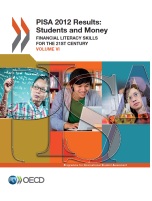PISA 2012 Results: Students and Money (Volume VI)
|
This sixth volume of PISA 2012 results examines 15-year-old students’ performance in financial literacy in the 18 countries and economies that participated in this optional assessment. It also discusses the relationship of financial literacy to students’ and their families’ background and to students’ mathematics and reading skills. The volume also explores students’ access to money and their experience with financial matters. In addition, it provides an overview of the current status of financial education in schools and highlights relevant case studies.
|
|
||||||
Country-specific overviews |
||||||||
|
Compare your country using the PISA 2012 data visualisation
|
||||||||
Contents |
||||||||
Foreword, Executive Summary, Reader's Guide, What is PISA? |
||||||||
Chapter 1 |
The Assessment of Financial Literacy in PISA |
|||||||
|
PISA 2012 is the first large-scale international study to assess the finanical literacy, learned in and outside of school, of 15-year-olds nearing the end of compulsory education. It assesses the extent to which students in 18 participating countries and economies have the knowledge and skills that are essential to make financial decisions and plans for their future. This chapter highlights the importance of financial literacy, defines financial education and financial literacy, and discusses how the assessment was organised. It also offers an overview of the limited and unveven provision of finanial education in schools in participating countries and economies, and describes the steps taken in some countries to improve financial literacy among students.
|
||||||||
Chapter 2 |
Student Performance in Financial Literacy |
|||||||
|
This chapter compares students' performance in the 2012 PISA financial literacy assessment across and within countries and economies. It discusses what students know about financial literacy and how well they can apply what they know, and examines how student performance in finanical literacy compares with performance in reading and mathematics. The analysis is complemented with contextual economic and finanical information about participating countries and its association with performance in financial literacy. > Snapshot of performance in Financial Literacy
|
||||||||
Chapter 3 |
Relationship between Financial Literacy and Student Background |
|||||||
|
This chapter examines the relationship between students' financial literacy and the demographic and socio-economic characteristics of these students and their families. In particular, the chapter looks at performance differences across gender, socio-economic status, parents' education, parents' occupation, immigrant background, and language spoken at home. The chapter then analyses how these different factors may be related to observed variations in students' financial literacy. |
||||||||
Chapter 4 |
Students' Experience Attitudes and Behaviour, and their Performance in Financial Literacy |
|||||||
|
This chapter explores the relationship between students' experiences with money matters (through holding bank accounts and debit cards and through their sources of money), and their performance in the financial literacy assessment. The chapter also analyses the relationship between students' attitudes and their performance in the assessment. It concludes by examining students' performance in relation to their behaviour in a hypothetical spending situation.
|
||||||||
Chapter 5 |
Selected Policy and Practical Implications of the Financial Literacy Assessment |
|||||||
|
Young people on the brink of adulthood are poised to make complex financial that will have an impact on the rest of their lives. Results from the PISA 2012 financial literacy assessment show that many students, including those living in countries that are high-performers in the main PISA assessment, need to improve their financial literacy. This chapter discusses selected implications of those results for policy and practice.
|
||||||||
Annexes |
Technical Background |
|||||||
Annex A |
Annex A1: Indices from the student context questionnaire Annex A2: The PISA target population, the PISA samples and the definition of schools Annex A3: Technical notes on analyses in this volume Annex A4: Quality assurance Annex A5: The design of the financial literacy assessment
|
|||||||
Annex B |
PISA 2012 Data
Results for countries and economies Chapter 1, Chapter 2, Chapter 3, Chapter 4 (Excel)
|
|||||||
Annex C |
The development and implementation of PISA - a collaborative effort |
|||||||
> Back to PISA 2012 Results for Volumes I, II, III, IV and V
Related Documents



